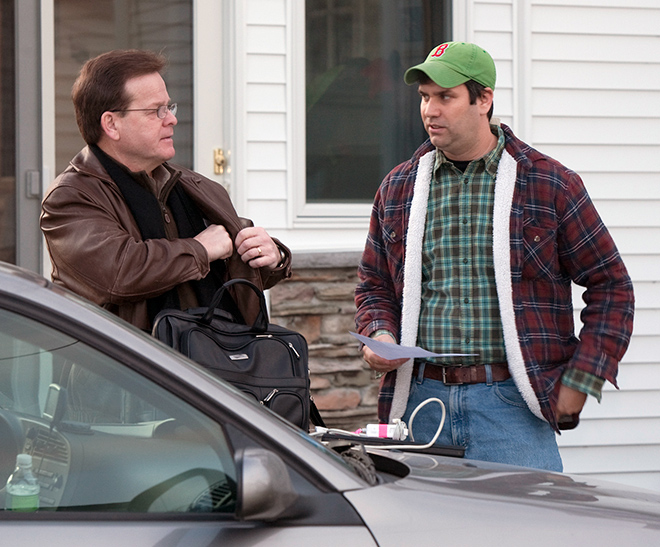
TSA Special Agent John Enright, left, speaks to Steven Frischling outside the blogger’s home in Niantic, Connecticut, after returning Frischling’s laptop Wednesday.
Photo: Thomas Cain/Wired.com
Special agents from the TSA’s Office of Inspection interrogated two U.S. bloggers, one of them an established travel columnist, and served them each with a civil subpoena demanding information on the anonymous source that provided the TSA document.
The document, which the two bloggers published within minutes of each other Dec. 27, was sent by TSA to airlines and airports around the world and described temporary new requirements for screening passengers through Dec. 30, including conducting “pat-downs” of legs and torsos. The document, which was not classified, was posted by numerous bloggers. Information from it was also published on some airline websites.
“They’re saying it’s a security document but it was sent to every airport and airline,” says Steven Frischling, one of the bloggers. “It was sent to Islamabad, to Riyadh and to Nigeria. So they’re looking for information about a security document sent to 10,000-plus people internationally. You can’t have a right to expect privacy after that.”
Transportation Security Administration spokeswoman Suzanne Trevino said in a statement that security directives “are not for public disclosure.”
“TSA’s Office of Inspections is currently investigating how the recent Security Directives were acquired and published by parties who should not have been privy to this information,” the statement said.
Frischling, a freelance travel writer and photographer in Connecticut who writes a blog for the KLM Royal Dutch Airlines, said the two agents who visited him arrived around 7 p.m. Tuesday, were armed and threatened him with a criminal search warrant if he didn’t provide the name of his source. They also threatened to get him fired from his KLM job and indicated they could get him designated a security risk, which would make it difficult for him to travel and do his job.
“They were indicating there would be significant ramifications if I didn’t cooperate,” said Frischling, who was home alone with his three children when the agents arrived. “It’s not hard to intimidate someone when they’re holding a 3-year-old [child] in their hands. My wife works at night. I go to jail, and my kids are here with nobody.”
Frischling, who described some of the details of the visit on his personal blog, told Threat Level that the two agents drove to his house in Connecticut from DHS offices in Massachusetts and New Jersey and didn’t mention a subpoena until an hour into their visit.
Read moreDHS Threatens Blogger Who Posted New TSA Screening Directive